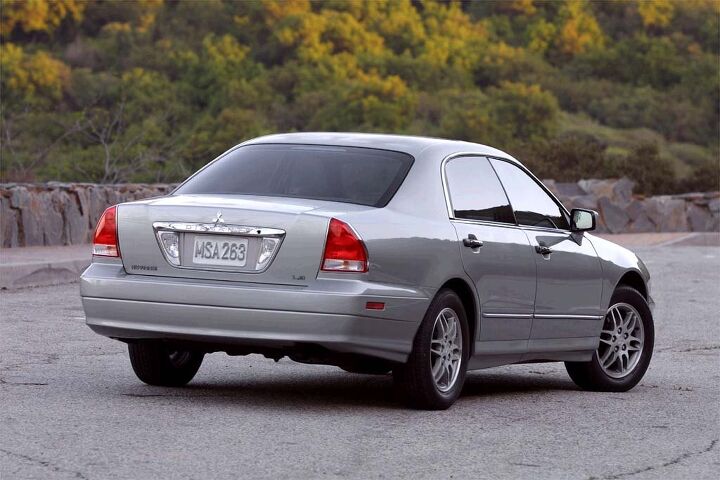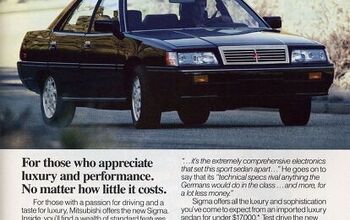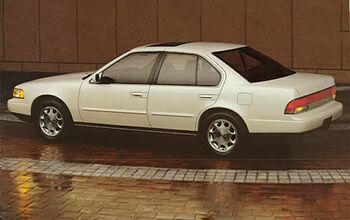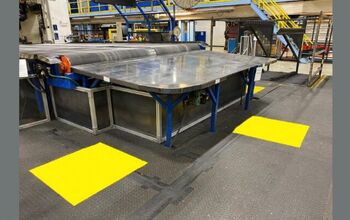Rare Rides Icons: The Mitsubishi Diamante Story (Part IV)

Last time on our Diamante coverage, we learned about the near-luxury sedan’s somewhat delayed introduction to America. In the two-year translation from a Japanese market car to an American one, Diamante lost the majority of its interesting and advanced tech features and adopted a cheaper suspension design. Today we’ll find out what happened when Mitsubishi pitched the new and de-contented Diamante against the Lexus ES 300.
In the U.S., Diamante was offered in the familiar ES and LS trims for 1997. Base price of the ES trim was $26,370 ($47,024 adj.), and stepped to $30,460 ($54,317 adj.) for the LS. But the Diamante was no longer a money-saving device over its direct competition. Mitsubishi felt the Diamante competed equally with the ES 300, so it priced it the same. In 1997, the ES 300 was available in only one trim, at $30,395 ($54,202 adj.). While we’re on the subject, Mitsubishi chose not to benchmark the Diamante’s size against the ES as it had with the Legend: Diamante was about four inches longer than the ES and had two inches over it on wheelbase length.
Mitsubishi fiddled with the Diamante over its first couple of model years and added an ABS system and keyless entry as standard on both ES and LS trims in 1998. There was no sunroof for 1997, though one appeared as standard equipment on LS in 1998. Was that an oversight for a premium midsize car? Slightly. Slow sales caused Mitsubishi to change strategy for 1999 when it offered the Diamante in a singular no-name trim. Based upon its price of $27,669 ($47,779 adj.), it was simply an unmarked ES. ES and LS trims returned in 2000, accompanied by a slight reworking of trim packages on the LS. The ES was the same base model it had been before but had a nice new standard CD player.
At this point, we should talk a bit about sales. The first Diamante was a slow seller, but Mitsubishi moved 22,112 and 25,267 in 1993 and 1994, respectively. By 1995 the old model was on its way out, and sales fell to just 2,718 in its fleet year of 1996. For 1997, the new Diamante breathed little life into the model’s sales prospects, as 11,402 sold. Unfortunately, that year was one of the high points for the second Diamante, as sales in 1998 were 8,563, 9,921 sold in 1999, and 9,219 in 2000.
It was time for a refresh for the ’02 model year to try and boost sales, and the Diamante received a new front and rear clip. At the front, the formerly cohesive grille was split into two parts by a new nose extension, where the metal of the hood extended in a point down to the bumper.
The rear end was also revised, with smaller and more formal European look (think Volvo S80) tail lamps. Said lamps were not fully removed from the styling of the prior lamps, but rather went without the lens portion that formerly extended onto the trunk. There was a new, larger chrome grab handle for the trunk that extended around new, larger reverse lamps. The license plate was festooned and highlighted on the revised Diamante, in a rear-end visual that was a bit overworked.
2002 also brought with it a new trim, the now-forgotten VR-X. Basically a sports appearance package, the VR-X used a slightly more powerful version of the 3.5-liter V6. An impressive 210 horsepower were available on VR-X, instead of 205 in the other trims.
The VR-X featured a more aggressive wheel design, black door handles, and an optional rear spoiler that was really too big. The VR-X was placed in the middle of the lineup, and asked $27,557 ($44,146 adj.) when the ES was $26,247 ($42,047 adj.) and the LS was $29,007 ($46,469 adj.). Worth noting here, the ask in 2002 for the unpopular Diamante was over 15 percent less than it was at the 1997 introduction.
The VR-X was edited slightly in 2003 and featured more distinguishing trim like a black grille in mesh instead of slats, more aggressive lower body cladding, and fender flares. There were also new sport design seats, but they were covered in cloth while the rear seat was leather (what?).
The update seemed to attract new buyers to Diamante, as sales increased in 2001 to 17,227. They quickly dropped off again in 2002, to 14,352. It was downhill from there, as US customers proved they really weren’t interested in the Diamante. But that meant it was time for another refresh, right?
That’s right, Diamante was changed again in 2004. In what would be its final edit and the final year for the model, the Diamante adopted a front look that was very similar to the Lancer. Now why a company would want their most expensive premium sedan to look just like their cheapest sedan offering is vexing, but that’s what they did. There was a new front bumper, new grille, very different headlamps, and a new hood.
Any sense of dignity the Diamante had in 2003 was erased in 2004, as the new sedan looked like a surprised Pokémon. The grille became upswept and more aggressive and was separated by a Diamond Star logo that was larger than ever. Headlamps were enormous and extended back into the fender in a (new generation) Lexus ES sort of way. The lower valance was grinning as much as the grille and headlamps and featured newly reintegrated fog lamps. Though the front end was a drastic departure from before, the rear was not changed, save for the swap of chrome trim for body-colored bits.
Changes on the interior included a different dashboard and center console area, and revised faux wood trim. There were also new paint colors available, and the too-big spoiler on the VR-X was standard instead of an optional extra. It seemed like Mitsubishi planned to keep the hodgepodge and mixed appearance Diamante around for a while.
However, the incredibly incongruous, cheapo effort didn’t work. Nobody wanted a mid-Nineties car design based in 1987 as a premium car in the mid-2000s. Sales tumbled in 2004 to just 4,379 examples. Mitsubishi canceled the American Diamante that year, though a few examples lingered on at dealers through 2005. One-hundred and sixty more were sold that year.
The 2004 Diamante is certainly a Rare Ride in itself, but an otherwise forgettable attempt to dress up an old car as midsize near-luxury. Nobody missed the second Diamante, and nobody who bought a Lexus ES really considered it as competitive. In Japan, the Diamante continued in its original 1995 format through 2005 with no visual refreshes. An eternity for a car to sell without any updates, Diamante of Japan was then canceled.
Diamante’s cancellation in Japan coincided with the cancellation of the Galant in that market, too. Galant carried on as the largest sedan Mitsubishi sold in North America through its end in 2012, as Mitsubishi’s lineup on this continent dwindled to a handful of models. So long, Diamante.
[Images: Mitsubishi]

Interested in lots of cars and their various historical contexts. Started writing articles for TTAC in late 2016, when my first posts were QOTDs. From there I started a few new series like Rare Rides, Buy/Drive/Burn, Abandoned History, and most recently Rare Rides Icons. Operating from a home base in Cincinnati, Ohio, a relative auto journalist dead zone. Many of my articles are prompted by something I'll see on social media that sparks my interest and causes me to research. Finding articles and information from the early days of the internet and beyond that covers the little details lost to time: trim packages, color and wheel choices, interior fabrics. Beyond those, I'm fascinated by automotive industry experiments, both failures and successes. Lately I've taken an interest in AI, and generating "what if" type images for car models long dead. Reincarnating a modern Toyota Paseo, Lincoln Mark IX, or Isuzu Trooper through a text prompt is fun. Fun to post them on Twitter too, and watch people overreact. To that end, the social media I use most is Twitter, @CoreyLewis86. I also contribute pieces for Forbes Wheels and Forbes Home.
More by Corey Lewis
Latest Car Reviews
Read moreLatest Product Reviews
Read moreRecent Comments
- MaintenanceCosts Whenever the topic of the xB comes up…Me: "The style is fun. The combination of the box shape and the aggressive detailing is very JDM."Wife: "Those are ghetto."Me: "They're smaller than a Corolla outside and have the space of a RAV4 inside."Wife: "Those are ghetto."Me: "They're kind of fun to drive with a stick."Wife: "Those are ghetto."It's one of a few cars (including its fellow box, the Ford Flex) on which we will just never see eye to eye.
- Oberkanone The alternative is a more expensive SUV. Yes, it will be missed.
- Ajla I did like this one.
- Zerofoo No, I won't miss this Chevrolet Malibu. It's a completely forgettable car. Who in their right mind would choose this over a V8 powered charger at the rental counter? Even the V6 charger is a far better drive.
- Offbeat Oddity Nope, I won't miss it. I loved the 2008-2012 Malibu, but the subsequent generations couldn't hold a candle to it. I think the Impala was much more compelling at the end.









































Comments
Join the conversation
Nobody's mentioned the 0-0-0 debacle of the early 2000s. No money down, 0% interest and no payments for the first 12 months not only about did in the company in America, but pretty much ever since Mitsubishi has been tainted with the stench of being the car of the last-resort buyer. No way you'll be mentioned in the same breath as Lexus under those circumstances, even if the product was up to the job (and in this case, it absolutely was not)
I recall that 2004 Diamante refresh like yesterday. Back in those days one of my uncles used to business travel on a bi-monthly basis from TX to CA and would pick a large sedan on the rental counter every time. He would spare some of that time to visit us. One of those days he showed up in one of these. It was silver, bland and the bloated Lancer front end didn't do it any favors. Neither did the mixup of late 90s materials including a previous gen Galant steering wheel. It was roomy, though. Next month he showed up on an early 2005 Chrysler 300. Even if it's long been considered a car with a cheap interior, it was Day and night difference both in and specially outside